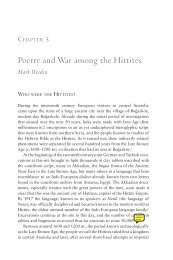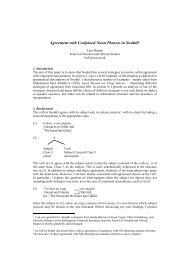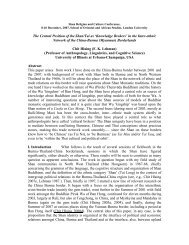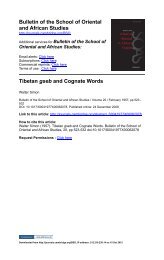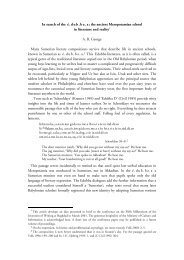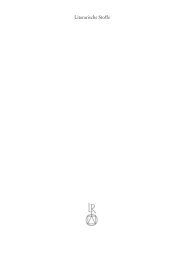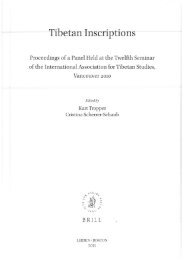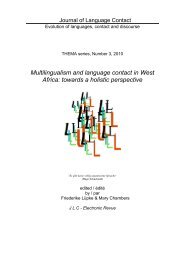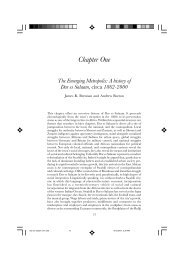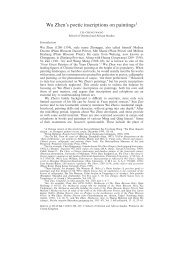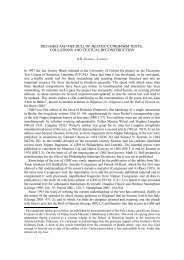Download (316Kb) - SOAS Research Online - The School of ...
Download (316Kb) - SOAS Research Online - The School of ...
Download (316Kb) - SOAS Research Online - The School of ...
You also want an ePaper? Increase the reach of your titles
YUMPU automatically turns print PDFs into web optimized ePapers that Google loves.
256 almut hintze<br />
Although different vocabularies are used in Iranian and Vedic, the first two<br />
stages <strong>of</strong> the Zoroastrian system, preceding the actual attack and denoted by<br />
Av. āgrpta- (Pahl. āgrift )andauuaoiriˇsta- (Pahl. ōiriˇst ) respectively, resemble<br />
apa-gur in Vedic law. Av. arduˇs- (Pahl. arduˇs ) and the blow to produce a<br />
non-bleeding wound, Av. vīxrūman. t- x v ara-, correspond to the Vedic second stage<br />
denoted by ni-han ‘to strike down’, while the varieties <strong>of</strong> Av. x v ara- (Pahl. xwar )<br />
involving blood as well as the ‘fatal blow’, Av. frazābaoδah- snaϑa-, agree with<br />
Vedic lohitam. kr<br />
˚ ‘to shed blood’. <strong>The</strong> Vedic and Avestan correspondences are<br />
summarized in the following table:<br />
Types <strong>of</strong> physical injury in Vedic and Avestan<br />
Stage Offence Vedic Avestan<br />
One: Seizing a weapon apa-gur ‘to raise āgrpta- seize a weapon<br />
Preparing for with the intention (one’s hand or<br />
an assault <strong>of</strong> physical attack weapon preparatory auuaoiriˇsta- turn a<br />
to striking)’ weapon against a person<br />
Two: Hitting a person ni-han arduˇs- snaϑa-<br />
Carrying out an with a weapon ‘to strike down’ a stroke which causes<br />
assault without but without the person hit to<br />
shedding blood shedding any blood shake and lose balance<br />
x v ara- vīxrūman. t- a<br />
non-bleeding injury<br />
Three: Hitting a person lohitam. kr<br />
˚<br />
xv Carrying out with a weapon so ‘to shed blood’<br />
ara- tacat.vohunīm<br />
a bleeding<br />
˜<br />
injury<br />
an assault with as to shed blood<br />
shedding blood xvara- astō.bid- injury<br />
resulting in fracture:<br />
1.bāzujata- <strong>of</strong> the arm<br />
2.yāta- <strong>of</strong> the leg<br />
frazābaoδah- snaϑaa<br />
fatal stroke<br />
As in the Rig-Vedic passages, in Vedic Prose the action denoted by apa-gur<br />
immediately precedes that expressed by the verb han. That such action consists<br />
in raising one’s arm in preparation for a stroke is suggested by the position taken<br />
by Ved. apa-gur in the classification <strong>of</strong> physical injuries. Like Av. āgrpta- and<br />
Wurzelkomposita 698-700. As an exocentric compound and an epithet <strong>of</strong> a blow or strike<br />
(snaϑa-), the literal meaning <strong>of</strong> frazābaoδah- is ‘characterized by leaving perception’. That<br />
perception (baoδah-) leaves the body at the moment <strong>of</strong> death, is stated in Vd 7.2 iˇsar pasca<br />
para.iristīm ... us haca baoδō aiiāt ‘immediately after death ... perception will go away<br />
from (the body).’<br />
˜



